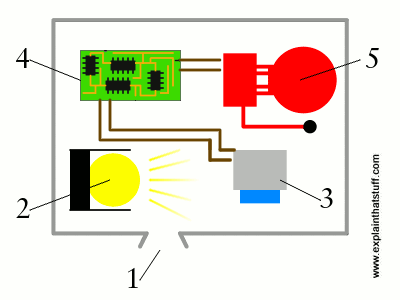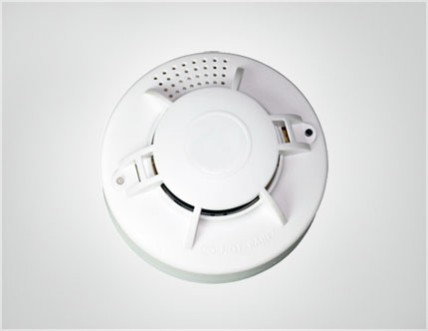by Chris Woodford. Last updated: May 31, 2016.
WWe´ve all heard of Native Americans who used smoke signals to send simple messages over long distances. But sometimes when we see smoke it´s sending a message that´s very alarming: there´s a fire nearby and our life is in danger. If fire breaks out in the daytime, we can usually smell it and do something about it. But if we´re asleep at night, fire can steal the oxygen we need to breathe or produce toxic carbon monoxide gas that can send us into a deep and deadly slumber from which we may never recover. In the United States, more people die from house fires than from all natural disasters combined. Fortunately, thanks to modern technology, there´s an inexpensive and very reliable way of detecting fires: the electronic smoke detector. How does this amazing gadget work?
Photo: An optical smoke detector. The chamber where smoke enters is the circular opening on the right. The dark circle in the middle is a test button with a built-in LED that flashes to show the detector is working okay.
How optical smoke detectors work
The answer to that question is really two answers, because there are two quite different kinds of smoke detectors. One is a kind of electronic eye; the other´s a sort of electronic nose. The eye type of detector is more properly called an optical smoke detector (or photocell smoke detector) and it works a bit like Tom Cruise in Mission Impossible. Remember the scene when Tom dangles from the ceiling trying to avoid all those light-detecting burglar beams? An optical smoke detector is just like that inside.

The detector must be screwed to your ceiling because that´s where smoke heads for when something starts to burn. Fire generates hot gases and because these are less dense (thinner—or weigh less per unit of volume) than ordinary air they rise upward, swirling tiny smoke particles up too. The detector is designed with a large opening in the bottom (1), shown upper right in our top photo, that leads to the detection chamber up above. An invisible, infrared light beam, similar to the ones that Tom Cruise dodged, shoots across the chamber from alight-emitting diode or LED (2) to a photocell (3). The photocell is an electronic light detector that generateselectricity for as long as light falls on it. Normally, when there is no smoke about, the light beam shoots constantly between the LED and the detector. An electronic circuit (4) detects that all is well and nothing happens. The alarm (5) remains silent.
But if a fire breaks out, smoke enters the chamber (6) and interrupts the beam (7). Because no light is falling on the photocell, it does not generate an electric current anymore. The circuit spots this straight away (8), realizes something´s amiss, and triggers the shrill and nasty alarm (9) that wakes you up and saves your life.

Another type of smoke alarm is less expensive than the optical type, more common, and works in a totally different way. You can think of it as an electronic nose because, like the nose on the front of your face, it uses a kind of chemistry to spot unusual molecules (smoke) heading inward. Detectors like this are called ionization smoke detectors.
What does that mean? Inside the detector, there´s an ionization chamber open to the air (1) filled with ions (2), which, in this case, are atoms that have lost electrons to make positively charged nuclei. Where do the ions come from? Inside the chamber, there´s a small piece of a chemical element called americium (3). It constantly spews out tiny radioactive particles (called alpha particles), which leak into the detection chamber. As they do so, they crash into air molecules and turn them into positively charged ions (shown here as big red blobs) and negatively charged electrons (shown as smaller black blobs). The ions and electrons whiz in opposite directions between two electrodes (electrical contacts, rather like the terminals of a battery). As long as the ions and electrons are moving, a current flows between the electrodes and a circuit (4) in the smoke detector thinks all´s well, so the alarm (5) remains silent.
However, if a fire breaks out, smoke particles get into the detector and start to clog up the ionization chamber (6). They attach themselves to the ions and effectively shut off the electric current (7). The circuit in the detector spots that change straight away (8) and sounds the alarm (9). Once the fire is out and the smoke is gone, the detection chamber clears, the ions travel back and forth between the electrodes as before, the circuit shuts down, and the alarm stops sounding.
You can see an example of an ionization detector, opened up, in the photo below:

Photo: An ionization smoke detector with the cover removed. The large black cylinder on the right is the ionization chamber where smoke is detected. Note the relatively simple electric circuit, made from basic components such as resistors and capacitors.

If you´ve not got a smoke detector in your home, why not? They cost just a few pounds/dollars and could save your life. Get one at once or, better still, get several and put them up in key places around your home. If you have got smoke detectors, make sure you check they work once a week (are the batteries still good?) and vacuum the dust out of them regularly. Get into the habit of checking detectors whenever you clean the room you´re in. A defective smoke detector is as bad as—or worse than—no detector at all, because it gives you a false sense of security.
Photo: Check smoke detectors regularly. Make sure the power light is working (this one has a green indicator that shows it´s OK) and vacuum out the dust from time to time. Note the "replace by" date too: smoke detectors don´t last forever!
According to a detailed study by the US National Institute of Standards and Technology: "Ionization type alarms provided somewhat better response to flaming fires than photoelectric alarms, and photoelectric alarms provide (often) considerably faster response to smoldering fires than ionization type alarms." Smoke detectors are trivially inexpensive compared to the cost of fire damage—and life, of course, is priceless. Although any smoke alarm is better than none, fit both types of detector if you possibly can.